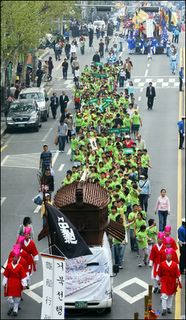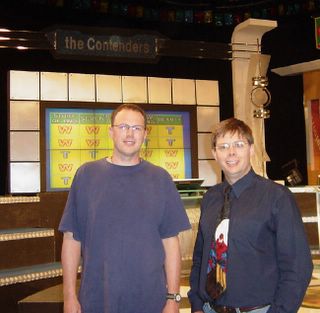I have been pecking away at cycling along the coast of Gangwondo. Last year, I was riding a mountain bike, very sturdy and dependable but slow and, actually, unnecessary. Almost all of my riding has been on excellent paved roads.
Anyway, the mountain bike was fine for getting into town and back but uncomfortable and, again, too slow for really long trips. I managed to ride between Hajodae and Seorak Ipgu, the main entrance to Seorak National Park. Some day, if I get even one comment asking for them, I'll post photos and suggestions for that stretch of coast.
I returned home to Canada for Christmas and came back with my road bike, the one I crossed most of Canada on a few years ago. Now, with a fast, comfortable bike, I'm able to do some bigger trips.
On Saturday, I headed north, hoping for Hwajinpo, with the plan of staying the night and going to the Unification Observatory Sunday morning, before heading home. Hwajinpo is much closer than I thought, about fifty kilometres. Conversely, bicycles are not allowed on the last 12 km to the Observatory.
Luckily, at the 12km point is a vehicle registation point for those heading further north and the friendly information booth attendant asked some motorists to drive me to and from the Observatory.
After the observatory, I returned to Hwajinpo, or possibly Daejin and spent the night. Sunday, I visited the Aquarium in Hwajinpo and went home.
Below are pictures, more details and a few suggestions for others planning a similar trip. On this trip, I hugged the coast as best I could. In future posts I will try to describe a few inland routes, which will probably make the trip more interesting. In really future posts, I hope to write about getting to Gangneung and even Donghae and Samcheok.
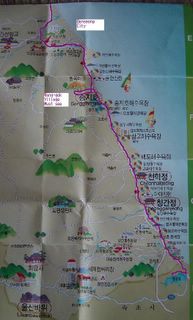
Sokcho to Wang-gok Village 

To the Observatory 

The things I carried 
Not shown: I am wearing cycling shorts and regular shorts, and a T-shirt. The padded cycling shorts make long trips more comforable but I am now a large-bellied man and wear nylon shorts for vanity. I wore socks and packed two more pair as I like to change socks to keep my feet comfortable.

Youngnang Lake 
I left my apartment and went to Youngnang Lake where a Hwarang training centre or theme park (I don't know which) had just opened. The Hwarang-in (exhibitors, competitors or park performers) were demonstrating mounted archery. I took some video but am having trouble with my movie maker software. Luckily, I had this photo (Below, from Naksan Temple, of all places) showing some unarmed combat training.

Hwarang Practice 
The Hwarang were knights of the Shilla Empire with similar goals and ideals as the Arthurian knights. Hwarang were a little more bookish, with quite a scholarly requirement and modern readings (in English, maybe the original Korean has a different emphasis) make them sound more like boy scouts than soldiers. On the other hand, I think Powell started scouting as a kind of training for soldiers.
From Youngnang Lake (which has a kayaking club!- flat water sprinting), I took Highway 7 north. Whenever I could, I took sideroads into the various fishing villages to get off highway 7 but I didn't know the area well enough to really hunt for alternate routes. I'll post them later as I do find them. Highway 7 had a broad, paved shoulder most of the time and I felt safer there than on many Canadian roads (Shame on you, Ontario for your shoulderless highways!). The highway is fine, with good paving, and if you are in a hurry, take it. Well, right now, you have to take it because I haven't shown you where else you can go.
After a village called Oho, I passed a pleasant lake, then turned off the highway to visit Wang-gok Village. I'd been there a few times in the past but it is really worth stopping at. For those who obsess over every kilometre, it was 1.5 km off the highway.
Wang-gok was spared during the Korean war and the Korean governement now offers the villagers incentives to keep their houses in the traditional style. There are many thatched roofs here but the effect would be better if the electrical connections were underground or somehow disguised. The effect could easily be a movie set, except for the over-abundance of overhead cables and TV antennaes. Oh well, I don't want to take from the vilagers quality of life.

Wang-gok Village 

Wang-gok Village 

Wang-gok Village 
From Wang-gok, I went back to the highway and mostly stayed on it the rest of the way. My tourist map (terrible for finding backroads, next time I will pay for a map) did show an inland road heading north but I felt lazy and stuck with the easy road. I did manage to go through fishing villages and be away from the highway for a few kilometres at a time but mos tof my trip was on the highway. On the map, you can see the town of Gangseong and the road goes a fair bit inland in a semi-circle loop returning to the ocean. I tried to find a straighter, more pleasant passage but the rivers seemed to have only one or two bridges so stay on the highway here.
After Gangseong, there is only a few tourist locations and the unification observatory so traffic really eases here and the highway drops to two lanes.
When you see signs for Geo-jin (거진, or 거진 11리해수욕장) follow them and the coast for the next few kilometres. You will eventually go inland and skirt a lake, reaching Hwajinpo. I spent more time in Hwajinpo on my return so I'll talk about it then. However, when you see the aquarium, there is a dirt road (maybe paved in a few weeks) on the right. Take it and it'll lead you into Dae-jin.
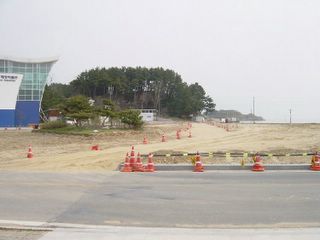
Take the dirt road on the right. Trust me. 
At the Observatory registration centre, I learned that I could not cycle the last 12 km. As I was talking to the information booth attendant, two Korean gentlemen came in. The attendant was able to arrange for them to drive me to the Observatory.
The men were Mr. Go and Mr. Lee. Here we are with the DMZ and North Korea in the background.

The men who drove me to the Observatory 
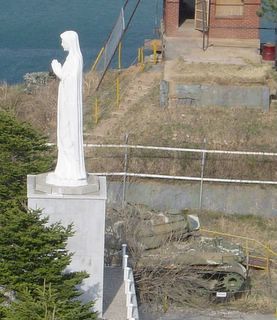
Mary: "Pray for me or the tank will fire!" 

The Buddha and Mary praying for their Northern flocks 
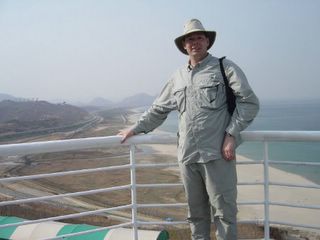
Observatory view 
At the registration centre and when getting out of the car at the Observatory, I almost fell down, my legs were so weak. At the end of the day, the odometer showed 64km, not far on mostly level ground. I am really out of shape.
After being dropped off at the registration centre, I rode south about 2 km to Dae-jin and stayed the night at the Ggot-saseum Minbak (minbak are like hostels, I guess). Hmm, the sign says Hwajinpo, maybe that's where I stayed ;) Most of the minbak were closed, waiting for the summer. This one was 25,000won, probably a somewhat better price than I could find in the summer.
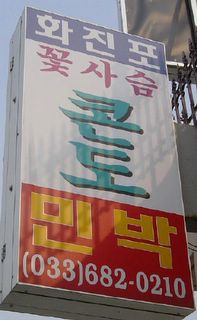
Ggot-saseum sign 
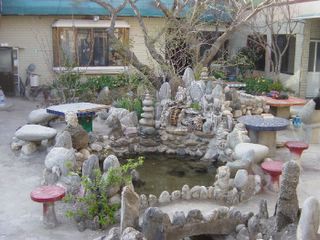
Ggot-saseum pond 
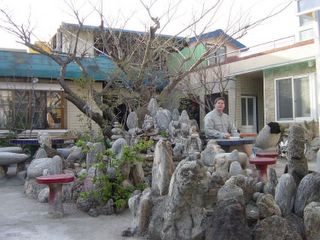
At the Ggo-saseum MInbak 
Sunday morning, I stopped at the Hwajinpo Aquarium. It was well worth the 5,000 won admission. Although they have many aqauriums, one diarama (SP?) caught my eye. It was too dark to photograph but the interior had many bright fish on the walls. It was exactly like I want my son's room to look like (if I haven't mentioned it before, I'll be a father in July!).
You can walk over the shark tank and look down into it. Some of the rays were patrolling the surface and I was able to reach over and touch one. On the floor below, you walk through a plexiglass tunnel and watch the sharks overhead.

A sad face? 
By the way, the eyes are on top of the ray. We are looking at the nostrils and mouth in this picture.
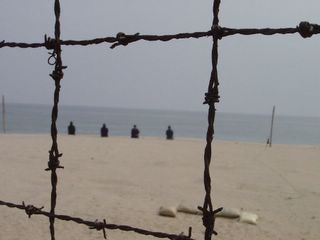
Fishermen? No, soldier cut-outs! 
Remember, when I said I hunted for a better route around Ganseong? That was when I saw these guys. I really did think they were fishermen at first. Sorry, my camera focussed on the fence and I didn't notice until I got home.
On Sunday, I dug in a little on the bike and just came straight back home. Oh, in Sokcho, I followed the coastline (with more success than in Gangseong) and took the Gaet-bae ( a small human powered ferry) across a channel. I may post pictures of it another day.
